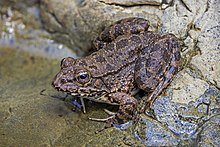Pelophylax
| Pelophylax Temporal range:
| |
|---|---|

| |
| Cyprus water frog P. cypriensis | |
| Scientific classification | |
| Domain: | Eukaryota |
| Kingdom: | Animalia |
| Phylum: | Chordata |
| Class: | Amphibia |
| Order: | Anura |
| Family: | Ranidae |
| Genus: | Pelophylax Fitzinger , 1843
|
| Type species | |
| Rana esculenta | |
| Diversity | |
| 25 species, some of which are hybridogenic | |
| Synonyms | |
| |
Pelophylax is a
They are also known as water frogs, as they spend much of the summer living in aquatic habitat; the pond frogs can be found more often, by comparison, on dry land, as long as there is sufficient humidity. Yet there are species of Eurasian green frogs – the Central Asian P. terentievi, or the Sahara frog (P. saharicus) – which inhabit waterholes in the desert.
Systematics and taxonomy
Most authors throughout the 19th and 20th century disagreed with Fitzinger's assessment. The green frogs were included again with the brown frogs, in line with the tendency to place any frog similar in
Around 2000, with
The Pelophylax frogs belong to a group of moderately advanced Raninae – possibly a
Evolution

Pelophylax is a rather old and well-represented genus, with articulated fossils from Europe known as far back as the Early Oligocene. It has been theorized that Pelophylax originated in Asia no later than 5 million years before the earliest known fossils, and then dispersed west. It may have colonized Europe in the wake of a cooling/drying trend and the resulting Eocene-Oligocene extinction event, as part of an overall replacement of Europe's previously tropical frog fauna of African origin (such as the pyxicephalid Thaumastosaurus) by a more temperate fauna of Asian origin.[4][5]
The oldest Pelophylax specimen is an articulated but headless specimen known from the earliest Oligocene of Chartres-de-Bretagne, France, which appears to be from the Pelophylax kl. esculentus hybrid complex. The species P. aquensis (formerly Rana aquensis) is known from the Late Oligocene of southern France, and fossil species become more common during the Miocene.[4][6]
Species
Including named
- Pelophylax bedriagae– Levant water frog
- Pelophylax bergeri– Italian pool frog
- Pelophylax caralitanus (Arikan, 1988) (formerly in P. bedriagae)
- Pelophylax cerigensis– Karpathos frog
- Pelophylax chosenicus– Seoul frog
- Pelophylax cretensis– Cretan frog
- Pelophylax cypriensis – Cyprus water frog
- Pelophylax demarchii (validity and taxonomic status unclear; klepton?)
- Pelophylax epeiroticus– Epirus water frog
- Pelophylax fukienensis (formerly in P. plancyi)
- Pelophylax hubeiensis (may belong in P. plancyi)
- Pelophylax kurtmuelleri– Balkan frog
- Pelophylax lessonae– pool frog
- Pelophylax nigromaculatus – dark-spotted frog (may include P. tenggerensis)
- Pelophylax perezi– Perez's frog
- Pelophylax plancyi– eastern golden frog (may include P. hubeiensis)
- Pelophylax porosus– Daruma pond frog
- Pelophylax ridibundus– marsh frog
- Pelophylax saharicus– Sahara frog
- Pelophylax shqipericus– Albanian water frog
- Pelophylax tenggerensis (may belong in P. nigromaculatus)
- Pelophylax terentievi (taxonomic status unclear; klepton?)
Named klepta (hybridogenic species) of Pelophylax are:
- Pelophylax kl. esculentus – edible frog(P. lessonae × P. ridibundus)
- Graf's hybrid frog(P. perezi × P. ridibundus)
- Pelophylax kl. hispanicus – Italian edible frog(P. bergeri × P. ridibundus / P. kl. esculentus)
In addition, one species has been described that is sometimes assigned to Pelophylax, but must be considered a nomen oblitum:
- "Hyla" ranaeformis Laurenti, 1768 (= "Hyla gibbosa" Lacépède, 1788 (unavailable: published in non-binomial work) )
The following fossil species are also known:[4][7]
- †Pelophylax aquensis (Late Oligocene of France)
- †Pelophylax barani (Middle/Late Miocene of Turkey)
- †Pelophylax meriani (Early Miocene of Germany)
- †Pelophylax pueyoi (Late Miocene of Spain)
- †Pelophylax quellenbergi (Late Miocene of Spain)
See also
References
- ^ doi:10.11646/zootaxa.1531.1.4. Archived from the original(PDF) on 2010-02-03.
- ^ PMID 18042407. Archived from the original(PDF) on 2016-03-03. Retrieved 2011-08-29.
- ^ a b c "Pelophylax". Amphibian Species of the World version 5.3. February 12, 2009. Retrieved March 22, 2009.
- ^ ISSN 0272-4634.
- ISSN 0024-4082.
- ISSN 0272-4634.
- ^ Sanchiz, B. (2012-01-01). "Nomenclatural notes on living and fossil amphibians". Graellsia.
External links
 Media related to Pelophylax at Wikimedia Commons
Media related to Pelophylax at Wikimedia Commons


